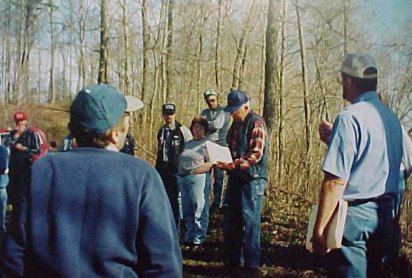However, there is the rare exception. Rick Kammler, Missouri Department of Conservation resource forester at Marble Hill, relates the experience of a landowner in his area.
Robert Dixon contacted MDC to ask if he could accompany a forester when a timber sale was being marked. He wanted to learn more about forest management, including how to determine which trees to cut and how best to market them. Dixon, who owns 500 acres of woodland on the Wayne-Bollinger County line, worked closely with Kammler. Dixon also has a Forest Stewardship plan that he follows closely.
Dixon decided to conduct his own timber sale on a 50-acre parcel of bottomland timber. He took lump sum bids on timber he marked himself and roughly scaled.
When the bids came in they were far below what he expected and he rejected all of them.
"Apparently, bidders then recognized that he knew what he was selling because the high bid on the second attempt was nearly three times higher than the previous high bid," reports Kammler.
Dixon's second sale was on a 40-acre site of mixed hardwoods, mostly oaks. This time, he kept track of the timber he marked by size and species, and estimated the quality grade. He then checked on current prices of the different grades to get an idea of the value. Again, he sought lump sum bids.
The same thing happened. Bids came in low. He then negotiated with the high bidder. He showed him the tally of the marked trees which included volumes by species, size and anticipated grades. From that tally the buyer determined that the value of the marked trees could, indeed, be higher than his high bid, but he was concerned that some of the trees might have hidden rot.
Buyer and seller then agreed that the buyer would pay on a guaranteed minimum somewhat higher than the original high bid. This was to be paid as a lump sum prior to the start of cutting. It was further agreed that the buyer would report to the seller on a weekly basis the volume, grade and price received for logs harvested from the site.
When the total value credited to Dixon equaled the guaranteed minimum amount, he was to receive (based on the agreed upon percentages for each grade) any excess over that amount. In this case, the timber value did exceed the minimum, so Dixon received additional payments bringing the total received to nearly 75 percent greater than the original high bid. As a comparison, that amount was 385 percent higher than the lowest bid. The actual amount was many thousands of dollars.

| Robert Dixon (center, plaid shirt) shares his knowledge of forest management. He also participates in the Community Forest Initiative (see related story). |
A third sale also added considerably to the owner's net income because of his marketing experience.
Kammler points out that a bonus was received by the landowner because when the trees were marked for sale the best immature trees were left standing.
"If all of the best trees had been cut he would have a difficult time attracting buyers when future sales are to be made since only poor- quality trees would be left to grow," notes Kammler.
The forester also notes that those high-quality, immature trees left in the stand will increase in value at a much faster rate after the stand was thinned. He also cautions that if a landowner is not willing to take the effort to learn about timber marketing and negotiating with bidders, he or she would be far ahead to hire a professional forester.